Strategic Business Plan: The Cape Town Restaurant Analysis
VerifiedAdded on 2020/05/16
|31
|8748
|365
Report
AI Summary
This report details a strategic business plan for The Cape Town Restaurant, covering various aspects essential for launching and developing a new venture in the restaurant industry. The report begins with an introduction to entrepreneurship and the company's mission to provide quality food and excellent customer service. It includes a description of the company, industry analysis, and a competitive analysis of key rivals like Miller’s Thumb and Reverie Social Table. The report also features a SWOT analysis, identifying strengths, weaknesses, opportunities, and threats. Furthermore, it explores potential growth strategies, including market penetration, market expansion, product expansion, diversification, and acquisition. The business plan section outlines objectives, strategies, and financial projections, culminating in a conclusion summarizing the key findings and recommendations. The report emphasizes the importance of change management, employee and customer relations, and the development of a strong brand image to ensure long-term success. The report also discusses key performance indicators (KPIs) and the importance of adapting to dynamic business requirements.
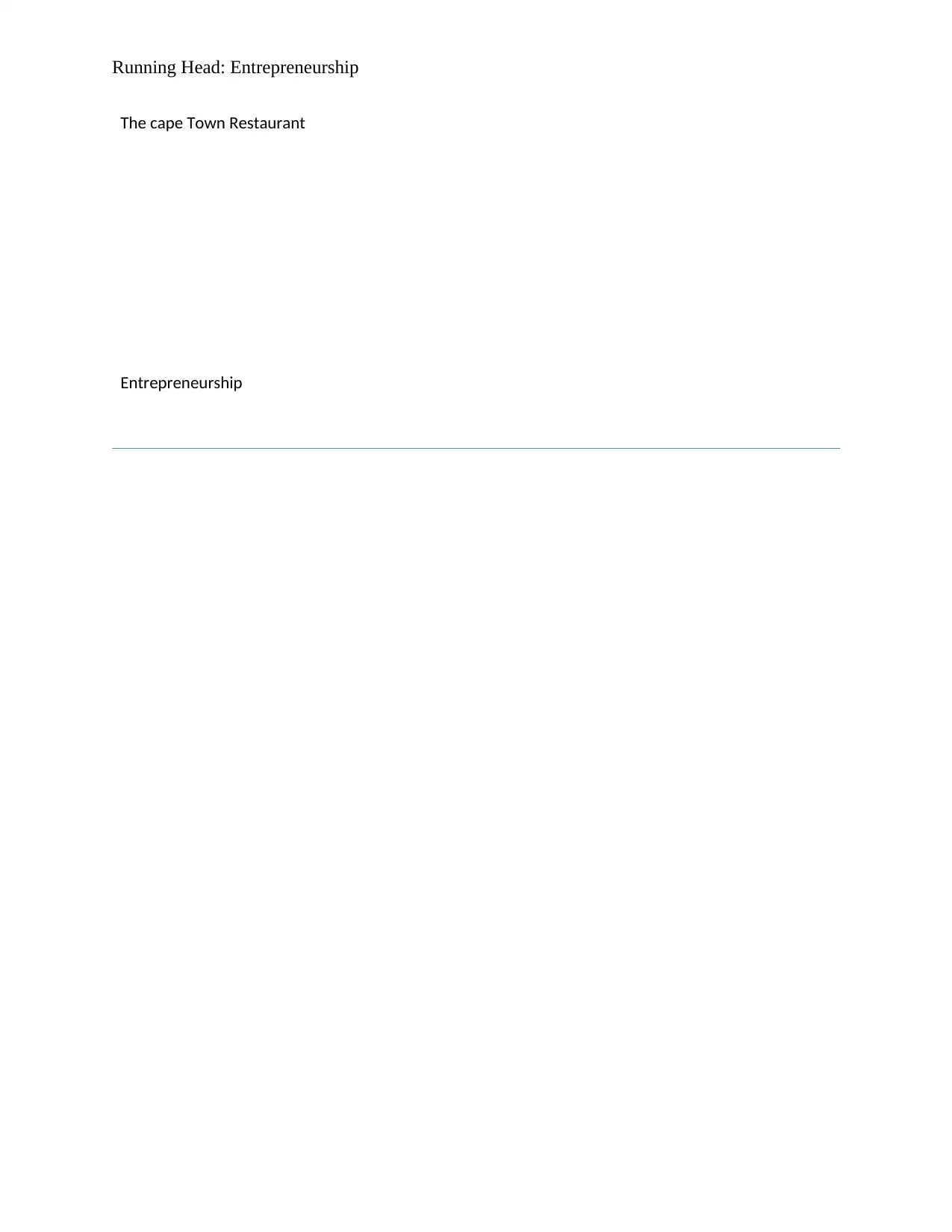
Running Head: Entrepreneurship
The cape Town Restaurant
Entrepreneurship
The cape Town Restaurant
Entrepreneurship
Paraphrase This Document
Need a fresh take? Get an instant paraphrase of this document with our AI Paraphraser
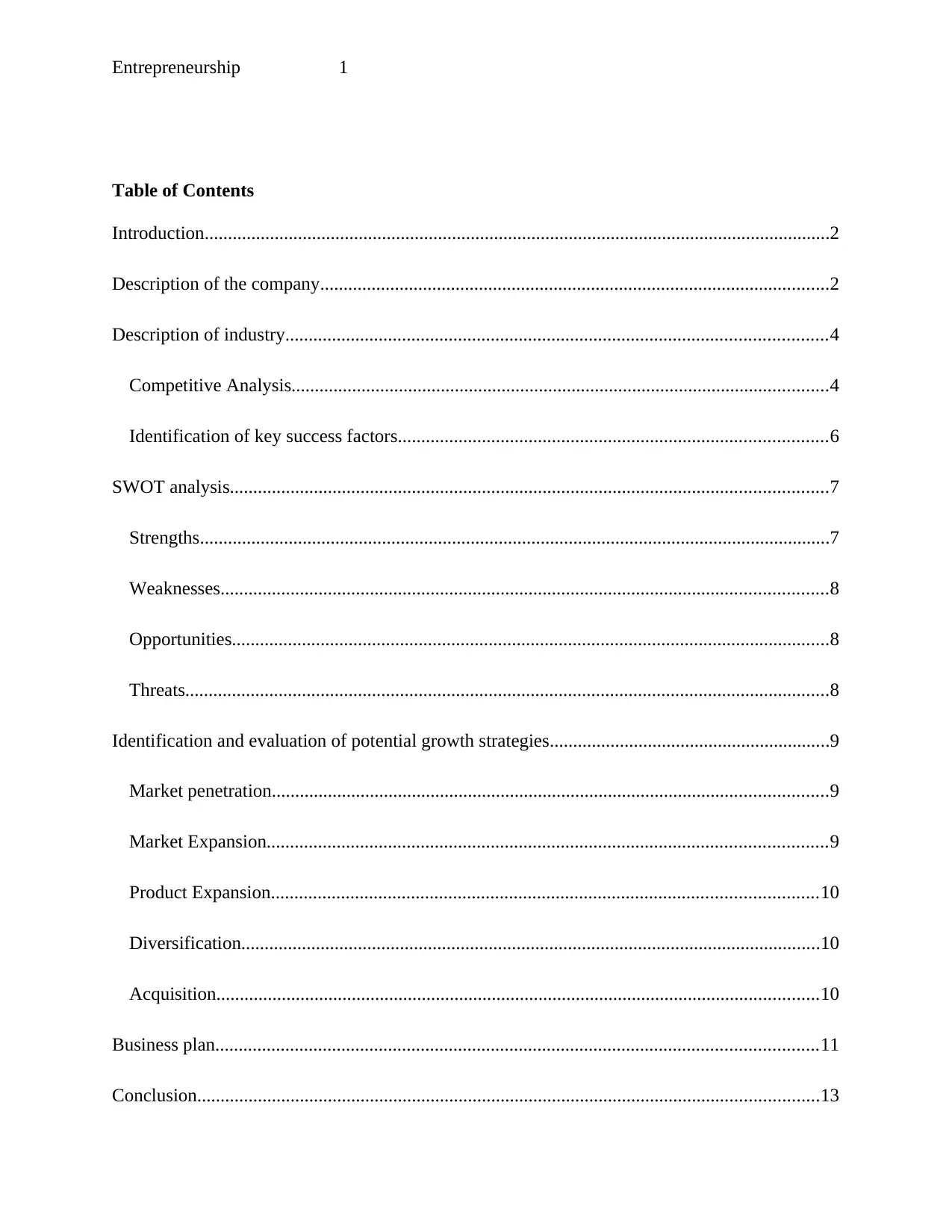
Entrepreneurship 1
Table of Contents
Introduction......................................................................................................................................2
Description of the company.............................................................................................................2
Description of industry....................................................................................................................4
Competitive Analysis...................................................................................................................4
Identification of key success factors............................................................................................6
SWOT analysis................................................................................................................................7
Strengths.......................................................................................................................................7
Weaknesses..................................................................................................................................8
Opportunities................................................................................................................................8
Threats..........................................................................................................................................8
Identification and evaluation of potential growth strategies............................................................9
Market penetration.......................................................................................................................9
Market Expansion........................................................................................................................9
Product Expansion.....................................................................................................................10
Diversification............................................................................................................................10
Acquisition.................................................................................................................................10
Business plan.................................................................................................................................11
Conclusion.....................................................................................................................................13
Table of Contents
Introduction......................................................................................................................................2
Description of the company.............................................................................................................2
Description of industry....................................................................................................................4
Competitive Analysis...................................................................................................................4
Identification of key success factors............................................................................................6
SWOT analysis................................................................................................................................7
Strengths.......................................................................................................................................7
Weaknesses..................................................................................................................................8
Opportunities................................................................................................................................8
Threats..........................................................................................................................................8
Identification and evaluation of potential growth strategies............................................................9
Market penetration.......................................................................................................................9
Market Expansion........................................................................................................................9
Product Expansion.....................................................................................................................10
Diversification............................................................................................................................10
Acquisition.................................................................................................................................10
Business plan.................................................................................................................................11
Conclusion.....................................................................................................................................13

Entrepreneurship 2
References......................................................................................................................................14
References......................................................................................................................................14
⊘ This is a preview!⊘
Do you want full access?
Subscribe today to unlock all pages.

Trusted by 1+ million students worldwide
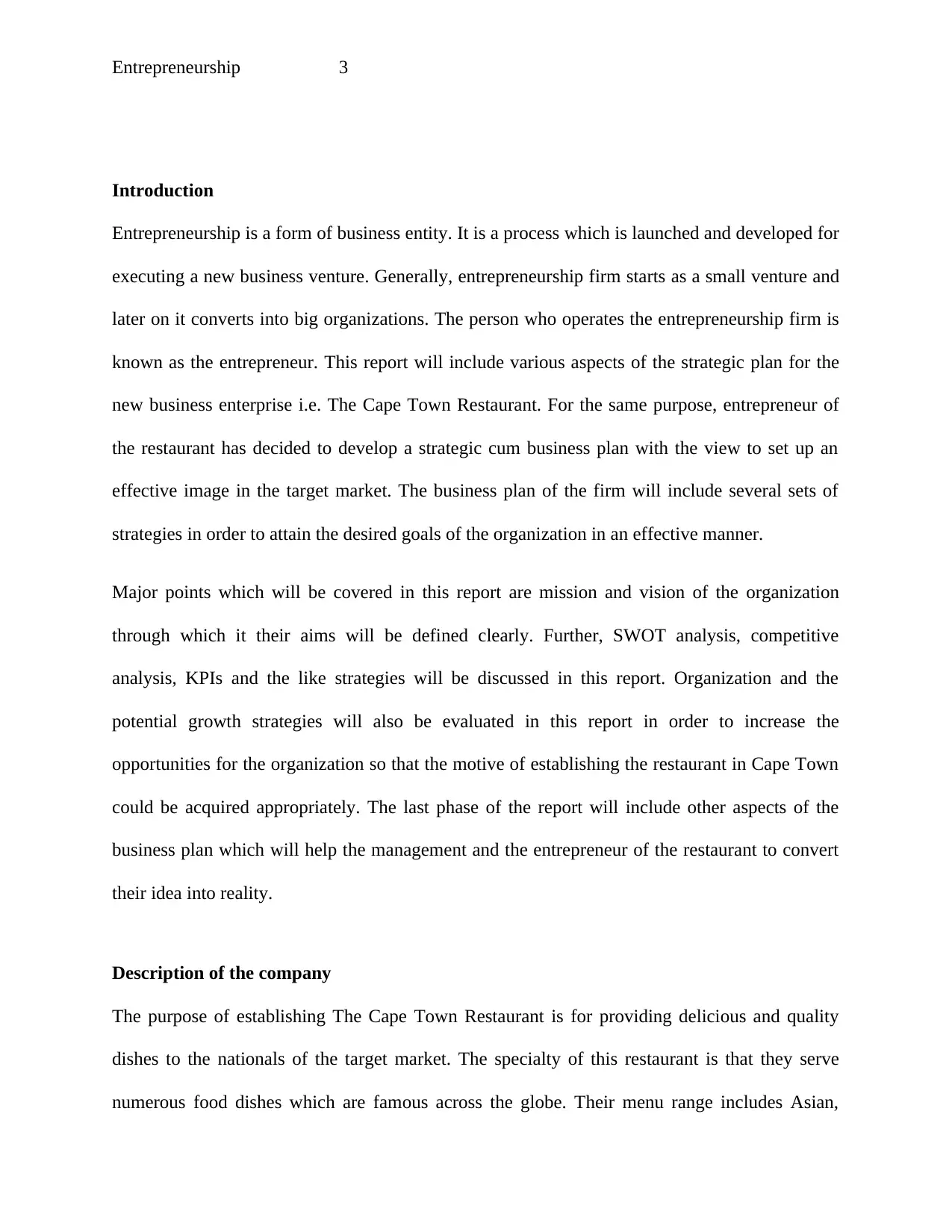
Entrepreneurship 3
Introduction
Entrepreneurship is a form of business entity. It is a process which is launched and developed for
executing a new business venture. Generally, entrepreneurship firm starts as a small venture and
later on it converts into big organizations. The person who operates the entrepreneurship firm is
known as the entrepreneur. This report will include various aspects of the strategic plan for the
new business enterprise i.e. The Cape Town Restaurant. For the same purpose, entrepreneur of
the restaurant has decided to develop a strategic cum business plan with the view to set up an
effective image in the target market. The business plan of the firm will include several sets of
strategies in order to attain the desired goals of the organization in an effective manner.
Major points which will be covered in this report are mission and vision of the organization
through which it their aims will be defined clearly. Further, SWOT analysis, competitive
analysis, KPIs and the like strategies will be discussed in this report. Organization and the
potential growth strategies will also be evaluated in this report in order to increase the
opportunities for the organization so that the motive of establishing the restaurant in Cape Town
could be acquired appropriately. The last phase of the report will include other aspects of the
business plan which will help the management and the entrepreneur of the restaurant to convert
their idea into reality.
Description of the company
The purpose of establishing The Cape Town Restaurant is for providing delicious and quality
dishes to the nationals of the target market. The specialty of this restaurant is that they serve
numerous food dishes which are famous across the globe. Their menu range includes Asian,
Introduction
Entrepreneurship is a form of business entity. It is a process which is launched and developed for
executing a new business venture. Generally, entrepreneurship firm starts as a small venture and
later on it converts into big organizations. The person who operates the entrepreneurship firm is
known as the entrepreneur. This report will include various aspects of the strategic plan for the
new business enterprise i.e. The Cape Town Restaurant. For the same purpose, entrepreneur of
the restaurant has decided to develop a strategic cum business plan with the view to set up an
effective image in the target market. The business plan of the firm will include several sets of
strategies in order to attain the desired goals of the organization in an effective manner.
Major points which will be covered in this report are mission and vision of the organization
through which it their aims will be defined clearly. Further, SWOT analysis, competitive
analysis, KPIs and the like strategies will be discussed in this report. Organization and the
potential growth strategies will also be evaluated in this report in order to increase the
opportunities for the organization so that the motive of establishing the restaurant in Cape Town
could be acquired appropriately. The last phase of the report will include other aspects of the
business plan which will help the management and the entrepreneur of the restaurant to convert
their idea into reality.
Description of the company
The purpose of establishing The Cape Town Restaurant is for providing delicious and quality
dishes to the nationals of the target market. The specialty of this restaurant is that they serve
numerous food dishes which are famous across the globe. Their menu range includes Asian,
Paraphrase This Document
Need a fresh take? Get an instant paraphrase of this document with our AI Paraphraser
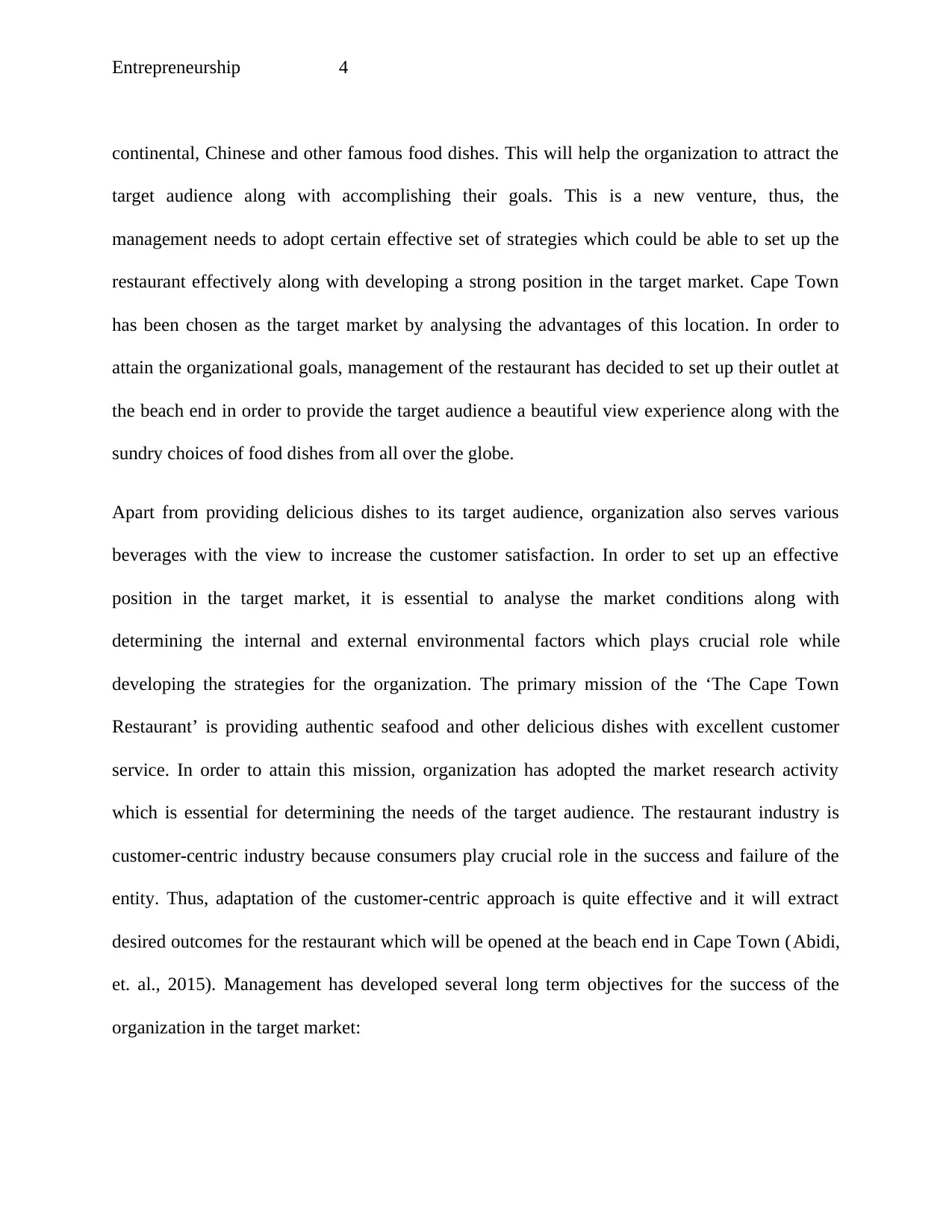
Entrepreneurship 4
continental, Chinese and other famous food dishes. This will help the organization to attract the
target audience along with accomplishing their goals. This is a new venture, thus, the
management needs to adopt certain effective set of strategies which could be able to set up the
restaurant effectively along with developing a strong position in the target market. Cape Town
has been chosen as the target market by analysing the advantages of this location. In order to
attain the organizational goals, management of the restaurant has decided to set up their outlet at
the beach end in order to provide the target audience a beautiful view experience along with the
sundry choices of food dishes from all over the globe.
Apart from providing delicious dishes to its target audience, organization also serves various
beverages with the view to increase the customer satisfaction. In order to set up an effective
position in the target market, it is essential to analyse the market conditions along with
determining the internal and external environmental factors which plays crucial role while
developing the strategies for the organization. The primary mission of the ‘The Cape Town
Restaurant’ is providing authentic seafood and other delicious dishes with excellent customer
service. In order to attain this mission, organization has adopted the market research activity
which is essential for determining the needs of the target audience. The restaurant industry is
customer-centric industry because consumers play crucial role in the success and failure of the
entity. Thus, adaptation of the customer-centric approach is quite effective and it will extract
desired outcomes for the restaurant which will be opened at the beach end in Cape Town (Abidi,
et. al., 2015). Management has developed several long term objectives for the success of the
organization in the target market:
continental, Chinese and other famous food dishes. This will help the organization to attract the
target audience along with accomplishing their goals. This is a new venture, thus, the
management needs to adopt certain effective set of strategies which could be able to set up the
restaurant effectively along with developing a strong position in the target market. Cape Town
has been chosen as the target market by analysing the advantages of this location. In order to
attain the organizational goals, management of the restaurant has decided to set up their outlet at
the beach end in order to provide the target audience a beautiful view experience along with the
sundry choices of food dishes from all over the globe.
Apart from providing delicious dishes to its target audience, organization also serves various
beverages with the view to increase the customer satisfaction. In order to set up an effective
position in the target market, it is essential to analyse the market conditions along with
determining the internal and external environmental factors which plays crucial role while
developing the strategies for the organization. The primary mission of the ‘The Cape Town
Restaurant’ is providing authentic seafood and other delicious dishes with excellent customer
service. In order to attain this mission, organization has adopted the market research activity
which is essential for determining the needs of the target audience. The restaurant industry is
customer-centric industry because consumers play crucial role in the success and failure of the
entity. Thus, adaptation of the customer-centric approach is quite effective and it will extract
desired outcomes for the restaurant which will be opened at the beach end in Cape Town (Abidi,
et. al., 2015). Management has developed several long term objectives for the success of the
organization in the target market:
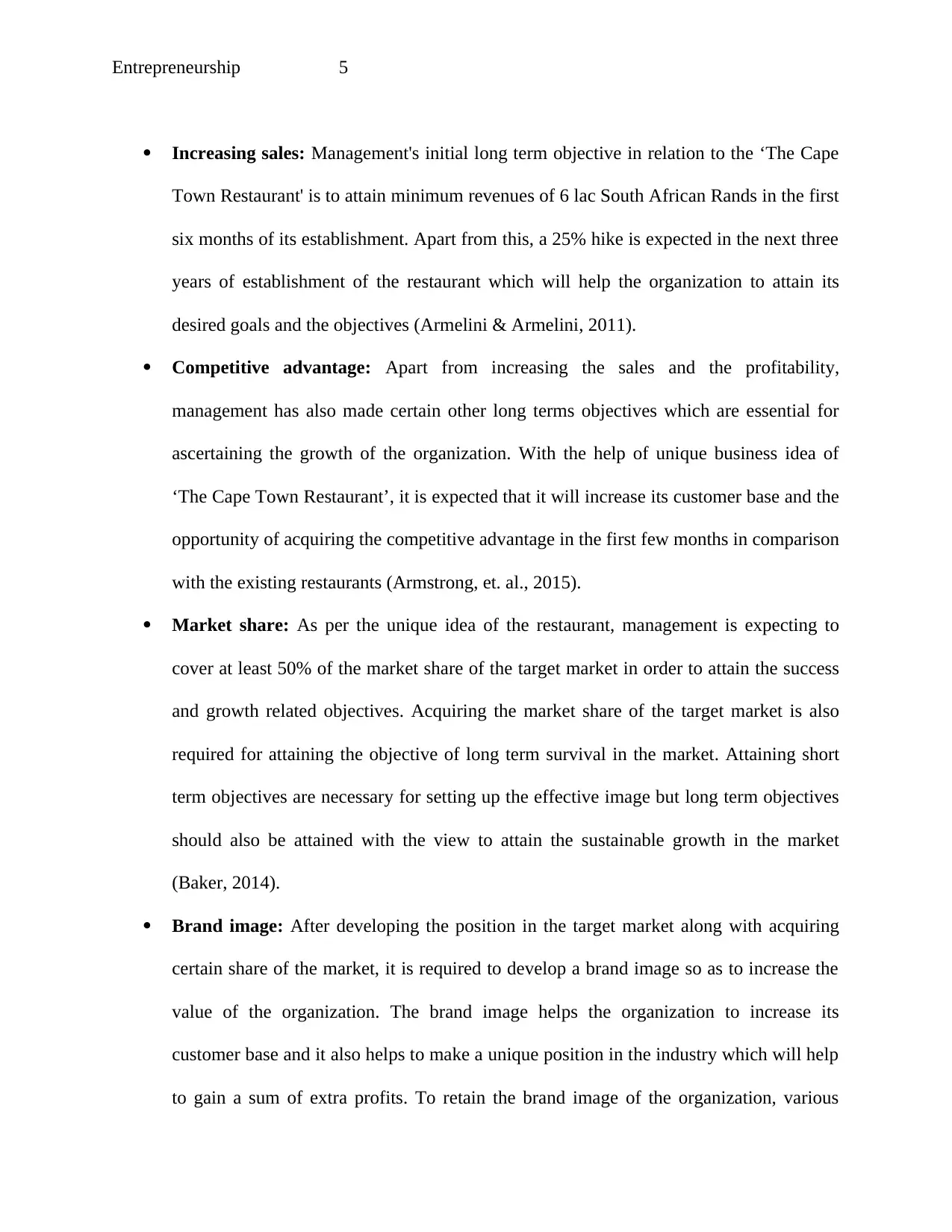
Entrepreneurship 5
Increasing sales: Management's initial long term objective in relation to the ‘The Cape
Town Restaurant' is to attain minimum revenues of 6 lac South African Rands in the first
six months of its establishment. Apart from this, a 25% hike is expected in the next three
years of establishment of the restaurant which will help the organization to attain its
desired goals and the objectives (Armelini & Armelini, 2011).
Competitive advantage: Apart from increasing the sales and the profitability,
management has also made certain other long terms objectives which are essential for
ascertaining the growth of the organization. With the help of unique business idea of
‘The Cape Town Restaurant’, it is expected that it will increase its customer base and the
opportunity of acquiring the competitive advantage in the first few months in comparison
with the existing restaurants (Armstrong, et. al., 2015).
Market share: As per the unique idea of the restaurant, management is expecting to
cover at least 50% of the market share of the target market in order to attain the success
and growth related objectives. Acquiring the market share of the target market is also
required for attaining the objective of long term survival in the market. Attaining short
term objectives are necessary for setting up the effective image but long term objectives
should also be attained with the view to attain the sustainable growth in the market
(Baker, 2014).
Brand image: After developing the position in the target market along with acquiring
certain share of the market, it is required to develop a brand image so as to increase the
value of the organization. The brand image helps the organization to increase its
customer base and it also helps to make a unique position in the industry which will help
to gain a sum of extra profits. To retain the brand image of the organization, various
Increasing sales: Management's initial long term objective in relation to the ‘The Cape
Town Restaurant' is to attain minimum revenues of 6 lac South African Rands in the first
six months of its establishment. Apart from this, a 25% hike is expected in the next three
years of establishment of the restaurant which will help the organization to attain its
desired goals and the objectives (Armelini & Armelini, 2011).
Competitive advantage: Apart from increasing the sales and the profitability,
management has also made certain other long terms objectives which are essential for
ascertaining the growth of the organization. With the help of unique business idea of
‘The Cape Town Restaurant’, it is expected that it will increase its customer base and the
opportunity of acquiring the competitive advantage in the first few months in comparison
with the existing restaurants (Armstrong, et. al., 2015).
Market share: As per the unique idea of the restaurant, management is expecting to
cover at least 50% of the market share of the target market in order to attain the success
and growth related objectives. Acquiring the market share of the target market is also
required for attaining the objective of long term survival in the market. Attaining short
term objectives are necessary for setting up the effective image but long term objectives
should also be attained with the view to attain the sustainable growth in the market
(Baker, 2014).
Brand image: After developing the position in the target market along with acquiring
certain share of the market, it is required to develop a brand image so as to increase the
value of the organization. The brand image helps the organization to increase its
customer base and it also helps to make a unique position in the industry which will help
to gain a sum of extra profits. To retain the brand image of the organization, various
⊘ This is a preview!⊘
Do you want full access?
Subscribe today to unlock all pages.

Trusted by 1+ million students worldwide
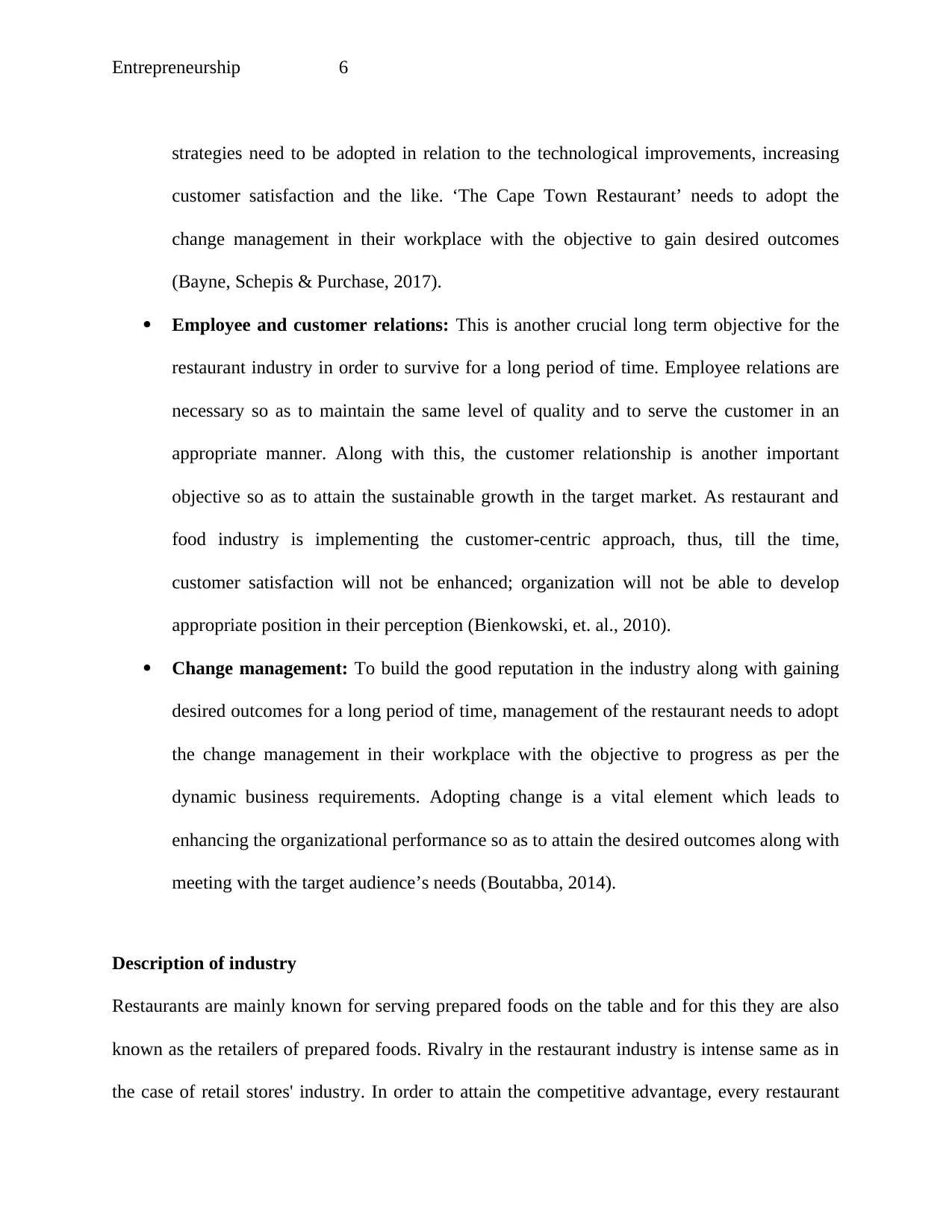
Entrepreneurship 6
strategies need to be adopted in relation to the technological improvements, increasing
customer satisfaction and the like. ‘The Cape Town Restaurant’ needs to adopt the
change management in their workplace with the objective to gain desired outcomes
(Bayne, Schepis & Purchase, 2017).
Employee and customer relations: This is another crucial long term objective for the
restaurant industry in order to survive for a long period of time. Employee relations are
necessary so as to maintain the same level of quality and to serve the customer in an
appropriate manner. Along with this, the customer relationship is another important
objective so as to attain the sustainable growth in the target market. As restaurant and
food industry is implementing the customer-centric approach, thus, till the time,
customer satisfaction will not be enhanced; organization will not be able to develop
appropriate position in their perception (Bienkowski, et. al., 2010).
Change management: To build the good reputation in the industry along with gaining
desired outcomes for a long period of time, management of the restaurant needs to adopt
the change management in their workplace with the objective to progress as per the
dynamic business requirements. Adopting change is a vital element which leads to
enhancing the organizational performance so as to attain the desired outcomes along with
meeting with the target audience’s needs (Boutabba, 2014).
Description of industry
Restaurants are mainly known for serving prepared foods on the table and for this they are also
known as the retailers of prepared foods. Rivalry in the restaurant industry is intense same as in
the case of retail stores' industry. In order to attain the competitive advantage, every restaurant
strategies need to be adopted in relation to the technological improvements, increasing
customer satisfaction and the like. ‘The Cape Town Restaurant’ needs to adopt the
change management in their workplace with the objective to gain desired outcomes
(Bayne, Schepis & Purchase, 2017).
Employee and customer relations: This is another crucial long term objective for the
restaurant industry in order to survive for a long period of time. Employee relations are
necessary so as to maintain the same level of quality and to serve the customer in an
appropriate manner. Along with this, the customer relationship is another important
objective so as to attain the sustainable growth in the target market. As restaurant and
food industry is implementing the customer-centric approach, thus, till the time,
customer satisfaction will not be enhanced; organization will not be able to develop
appropriate position in their perception (Bienkowski, et. al., 2010).
Change management: To build the good reputation in the industry along with gaining
desired outcomes for a long period of time, management of the restaurant needs to adopt
the change management in their workplace with the objective to progress as per the
dynamic business requirements. Adopting change is a vital element which leads to
enhancing the organizational performance so as to attain the desired outcomes along with
meeting with the target audience’s needs (Boutabba, 2014).
Description of industry
Restaurants are mainly known for serving prepared foods on the table and for this they are also
known as the retailers of prepared foods. Rivalry in the restaurant industry is intense same as in
the case of retail stores' industry. In order to attain the competitive advantage, every restaurant
Paraphrase This Document
Need a fresh take? Get an instant paraphrase of this document with our AI Paraphraser
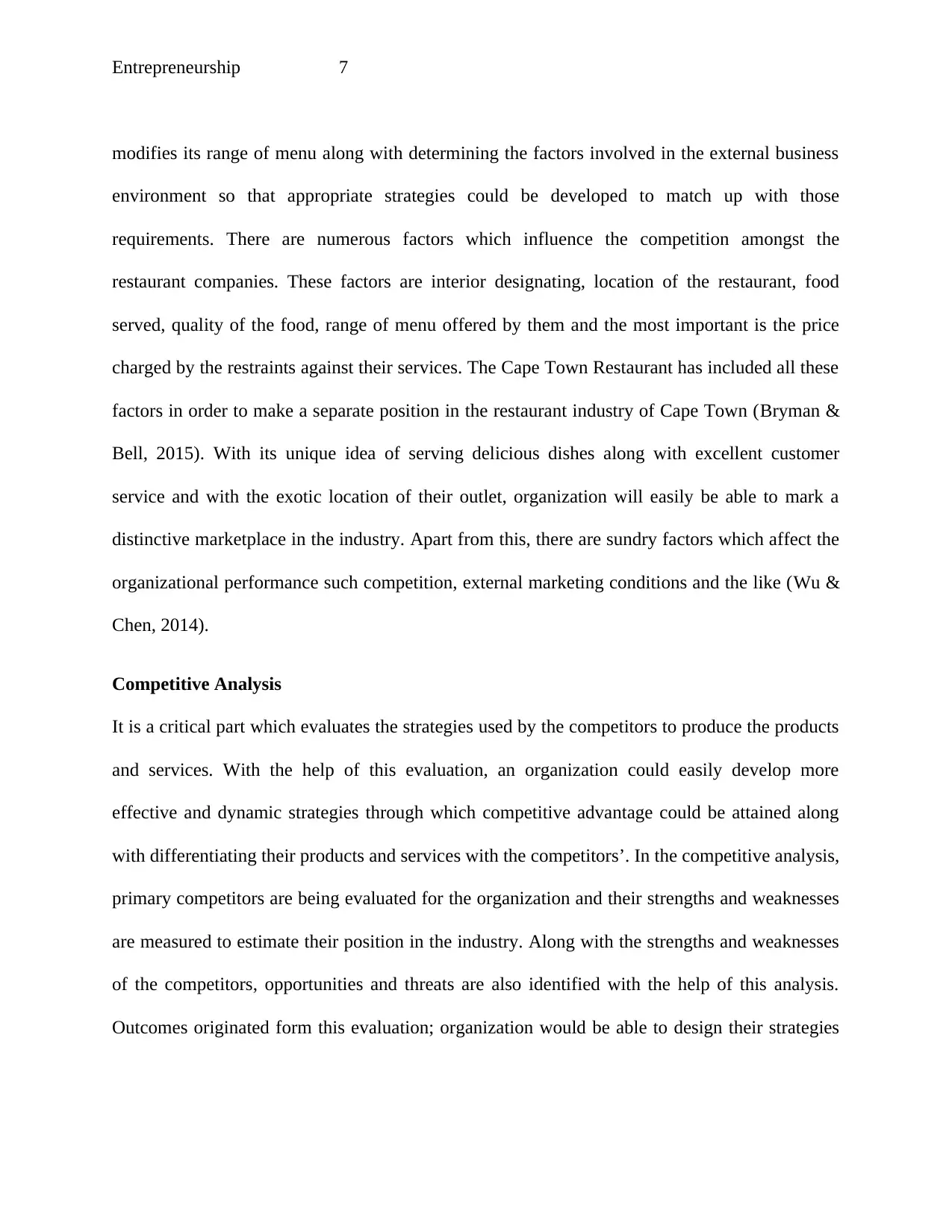
Entrepreneurship 7
modifies its range of menu along with determining the factors involved in the external business
environment so that appropriate strategies could be developed to match up with those
requirements. There are numerous factors which influence the competition amongst the
restaurant companies. These factors are interior designating, location of the restaurant, food
served, quality of the food, range of menu offered by them and the most important is the price
charged by the restraints against their services. The Cape Town Restaurant has included all these
factors in order to make a separate position in the restaurant industry of Cape Town (Bryman &
Bell, 2015). With its unique idea of serving delicious dishes along with excellent customer
service and with the exotic location of their outlet, organization will easily be able to mark a
distinctive marketplace in the industry. Apart from this, there are sundry factors which affect the
organizational performance such competition, external marketing conditions and the like (Wu &
Chen, 2014).
Competitive Analysis
It is a critical part which evaluates the strategies used by the competitors to produce the products
and services. With the help of this evaluation, an organization could easily develop more
effective and dynamic strategies through which competitive advantage could be attained along
with differentiating their products and services with the competitors’. In the competitive analysis,
primary competitors are being evaluated for the organization and their strengths and weaknesses
are measured to estimate their position in the industry. Along with the strengths and weaknesses
of the competitors, opportunities and threats are also identified with the help of this analysis.
Outcomes originated form this evaluation; organization would be able to design their strategies
modifies its range of menu along with determining the factors involved in the external business
environment so that appropriate strategies could be developed to match up with those
requirements. There are numerous factors which influence the competition amongst the
restaurant companies. These factors are interior designating, location of the restaurant, food
served, quality of the food, range of menu offered by them and the most important is the price
charged by the restraints against their services. The Cape Town Restaurant has included all these
factors in order to make a separate position in the restaurant industry of Cape Town (Bryman &
Bell, 2015). With its unique idea of serving delicious dishes along with excellent customer
service and with the exotic location of their outlet, organization will easily be able to mark a
distinctive marketplace in the industry. Apart from this, there are sundry factors which affect the
organizational performance such competition, external marketing conditions and the like (Wu &
Chen, 2014).
Competitive Analysis
It is a critical part which evaluates the strategies used by the competitors to produce the products
and services. With the help of this evaluation, an organization could easily develop more
effective and dynamic strategies through which competitive advantage could be attained along
with differentiating their products and services with the competitors’. In the competitive analysis,
primary competitors are being evaluated for the organization and their strengths and weaknesses
are measured to estimate their position in the industry. Along with the strengths and weaknesses
of the competitors, opportunities and threats are also identified with the help of this analysis.
Outcomes originated form this evaluation; organization would be able to design their strategies
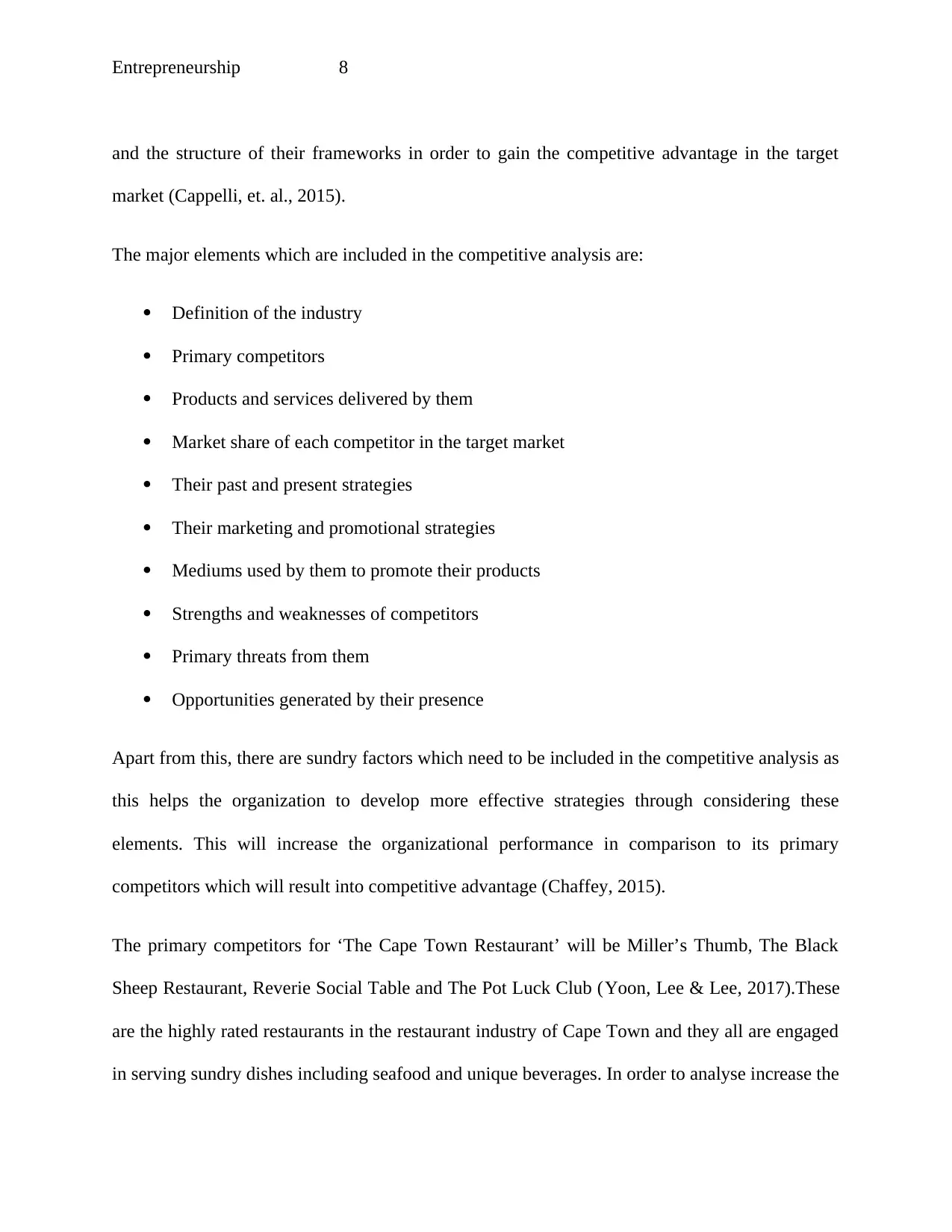
Entrepreneurship 8
and the structure of their frameworks in order to gain the competitive advantage in the target
market (Cappelli, et. al., 2015).
The major elements which are included in the competitive analysis are:
Definition of the industry
Primary competitors
Products and services delivered by them
Market share of each competitor in the target market
Their past and present strategies
Their marketing and promotional strategies
Mediums used by them to promote their products
Strengths and weaknesses of competitors
Primary threats from them
Opportunities generated by their presence
Apart from this, there are sundry factors which need to be included in the competitive analysis as
this helps the organization to develop more effective strategies through considering these
elements. This will increase the organizational performance in comparison to its primary
competitors which will result into competitive advantage (Chaffey, 2015).
The primary competitors for ‘The Cape Town Restaurant’ will be Miller’s Thumb, The Black
Sheep Restaurant, Reverie Social Table and The Pot Luck Club (Yoon, Lee & Lee, 2017).These
are the highly rated restaurants in the restaurant industry of Cape Town and they all are engaged
in serving sundry dishes including seafood and unique beverages. In order to analyse increase the
and the structure of their frameworks in order to gain the competitive advantage in the target
market (Cappelli, et. al., 2015).
The major elements which are included in the competitive analysis are:
Definition of the industry
Primary competitors
Products and services delivered by them
Market share of each competitor in the target market
Their past and present strategies
Their marketing and promotional strategies
Mediums used by them to promote their products
Strengths and weaknesses of competitors
Primary threats from them
Opportunities generated by their presence
Apart from this, there are sundry factors which need to be included in the competitive analysis as
this helps the organization to develop more effective strategies through considering these
elements. This will increase the organizational performance in comparison to its primary
competitors which will result into competitive advantage (Chaffey, 2015).
The primary competitors for ‘The Cape Town Restaurant’ will be Miller’s Thumb, The Black
Sheep Restaurant, Reverie Social Table and The Pot Luck Club (Yoon, Lee & Lee, 2017).These
are the highly rated restaurants in the restaurant industry of Cape Town and they all are engaged
in serving sundry dishes including seafood and unique beverages. In order to analyse increase the
⊘ This is a preview!⊘
Do you want full access?
Subscribe today to unlock all pages.

Trusted by 1+ million students worldwide
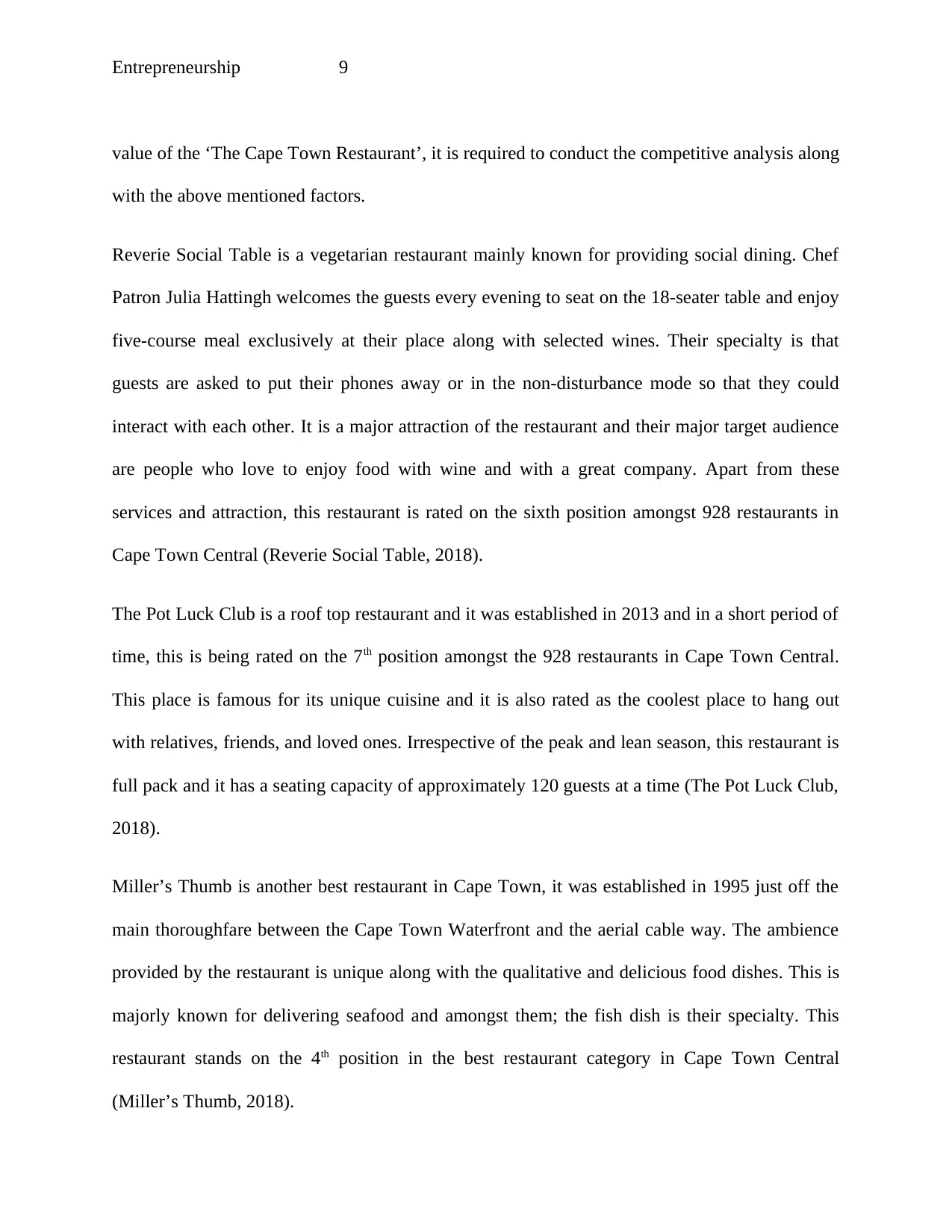
Entrepreneurship 9
value of the ‘The Cape Town Restaurant’, it is required to conduct the competitive analysis along
with the above mentioned factors.
Reverie Social Table is a vegetarian restaurant mainly known for providing social dining. Chef
Patron Julia Hattingh welcomes the guests every evening to seat on the 18-seater table and enjoy
five-course meal exclusively at their place along with selected wines. Their specialty is that
guests are asked to put their phones away or in the non-disturbance mode so that they could
interact with each other. It is a major attraction of the restaurant and their major target audience
are people who love to enjoy food with wine and with a great company. Apart from these
services and attraction, this restaurant is rated on the sixth position amongst 928 restaurants in
Cape Town Central (Reverie Social Table, 2018).
The Pot Luck Club is a roof top restaurant and it was established in 2013 and in a short period of
time, this is being rated on the 7th position amongst the 928 restaurants in Cape Town Central.
This place is famous for its unique cuisine and it is also rated as the coolest place to hang out
with relatives, friends, and loved ones. Irrespective of the peak and lean season, this restaurant is
full pack and it has a seating capacity of approximately 120 guests at a time (The Pot Luck Club,
2018).
Miller’s Thumb is another best restaurant in Cape Town, it was established in 1995 just off the
main thoroughfare between the Cape Town Waterfront and the aerial cable way. The ambience
provided by the restaurant is unique along with the qualitative and delicious food dishes. This is
majorly known for delivering seafood and amongst them; the fish dish is their specialty. This
restaurant stands on the 4th position in the best restaurant category in Cape Town Central
(Miller’s Thumb, 2018).
value of the ‘The Cape Town Restaurant’, it is required to conduct the competitive analysis along
with the above mentioned factors.
Reverie Social Table is a vegetarian restaurant mainly known for providing social dining. Chef
Patron Julia Hattingh welcomes the guests every evening to seat on the 18-seater table and enjoy
five-course meal exclusively at their place along with selected wines. Their specialty is that
guests are asked to put their phones away or in the non-disturbance mode so that they could
interact with each other. It is a major attraction of the restaurant and their major target audience
are people who love to enjoy food with wine and with a great company. Apart from these
services and attraction, this restaurant is rated on the sixth position amongst 928 restaurants in
Cape Town Central (Reverie Social Table, 2018).
The Pot Luck Club is a roof top restaurant and it was established in 2013 and in a short period of
time, this is being rated on the 7th position amongst the 928 restaurants in Cape Town Central.
This place is famous for its unique cuisine and it is also rated as the coolest place to hang out
with relatives, friends, and loved ones. Irrespective of the peak and lean season, this restaurant is
full pack and it has a seating capacity of approximately 120 guests at a time (The Pot Luck Club,
2018).
Miller’s Thumb is another best restaurant in Cape Town, it was established in 1995 just off the
main thoroughfare between the Cape Town Waterfront and the aerial cable way. The ambience
provided by the restaurant is unique along with the qualitative and delicious food dishes. This is
majorly known for delivering seafood and amongst them; the fish dish is their specialty. This
restaurant stands on the 4th position in the best restaurant category in Cape Town Central
(Miller’s Thumb, 2018).
Paraphrase This Document
Need a fresh take? Get an instant paraphrase of this document with our AI Paraphraser

Entrepreneurship 10
The Black Sheep Restaurant is running since 20 years in the UK and South Africa. This stands
on the 8th position in the top rated restaurants in the Cape Town Central. Irrespective of the
seasons, menu range of the restaurant serves fix dishes on daily basis following the tradition of
The Black Sheep is always about making merry, with the best quality food and best service. No
one leaves The Black Sheep hungry (The Black Sheep Restaurant, 2018).
Reviewing all these strengths and weaknesses of these competitors, ‘The Cape Town Restaurant'
could be able to mold their strategies in such a way so that competitive advantage could be
attained easily. With the help of these strategies, organization will be able to develop a distinct
position in the target market along with its unique business idea of opening the outlet at the
beach end. This will help the organization to attain its desired goals. The strategies which could
be adopted for attaining the competitive advantage are cost leadership, product differentiation
approach, and the like. These are two approaches which help the organization to increase its
effectiveness in the target market along with setting up a competitive place in comparison to the
existing restaurant companies (Chang, 2016).
Cost leadership approach describes a reduction of unnecessary costs in order to set the affordable
prices for the finished goods. Restaurant companies which are known for serving prepared food
could also adopt this strategy with the objective to lower down the prices of the dishes served
within the restaurant for a certain period of time, mainly for the initial period from setting up the
outlet. This approach will help the organization to attract large number of customers irrespective
of their segments (Yu, et. al., 2016). With the large customer base, an organization would be able
to accomplish its short term objectives of reaching the desired mark of sales and revenues with a
certain margin of profitability. Along with this, cost leadership approach also leads to the
The Black Sheep Restaurant is running since 20 years in the UK and South Africa. This stands
on the 8th position in the top rated restaurants in the Cape Town Central. Irrespective of the
seasons, menu range of the restaurant serves fix dishes on daily basis following the tradition of
The Black Sheep is always about making merry, with the best quality food and best service. No
one leaves The Black Sheep hungry (The Black Sheep Restaurant, 2018).
Reviewing all these strengths and weaknesses of these competitors, ‘The Cape Town Restaurant'
could be able to mold their strategies in such a way so that competitive advantage could be
attained easily. With the help of these strategies, organization will be able to develop a distinct
position in the target market along with its unique business idea of opening the outlet at the
beach end. This will help the organization to attain its desired goals. The strategies which could
be adopted for attaining the competitive advantage are cost leadership, product differentiation
approach, and the like. These are two approaches which help the organization to increase its
effectiveness in the target market along with setting up a competitive place in comparison to the
existing restaurant companies (Chang, 2016).
Cost leadership approach describes a reduction of unnecessary costs in order to set the affordable
prices for the finished goods. Restaurant companies which are known for serving prepared food
could also adopt this strategy with the objective to lower down the prices of the dishes served
within the restaurant for a certain period of time, mainly for the initial period from setting up the
outlet. This approach will help the organization to attract large number of customers irrespective
of their segments (Yu, et. al., 2016). With the large customer base, an organization would be able
to accomplish its short term objectives of reaching the desired mark of sales and revenues with a
certain margin of profitability. Along with this, cost leadership approach also leads to the
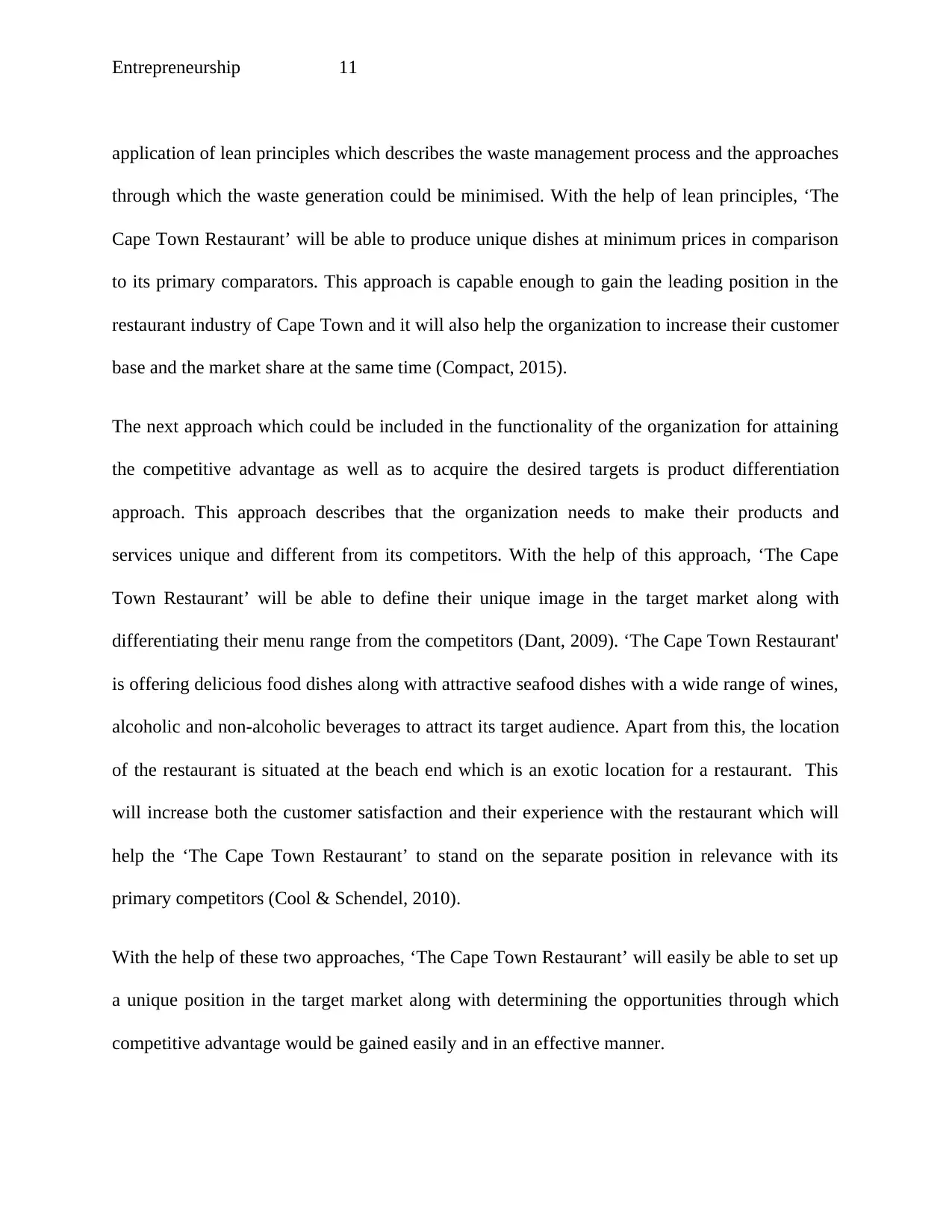
Entrepreneurship 11
application of lean principles which describes the waste management process and the approaches
through which the waste generation could be minimised. With the help of lean principles, ‘The
Cape Town Restaurant’ will be able to produce unique dishes at minimum prices in comparison
to its primary comparators. This approach is capable enough to gain the leading position in the
restaurant industry of Cape Town and it will also help the organization to increase their customer
base and the market share at the same time (Compact, 2015).
The next approach which could be included in the functionality of the organization for attaining
the competitive advantage as well as to acquire the desired targets is product differentiation
approach. This approach describes that the organization needs to make their products and
services unique and different from its competitors. With the help of this approach, ‘The Cape
Town Restaurant’ will be able to define their unique image in the target market along with
differentiating their menu range from the competitors (Dant, 2009). ‘The Cape Town Restaurant'
is offering delicious food dishes along with attractive seafood dishes with a wide range of wines,
alcoholic and non-alcoholic beverages to attract its target audience. Apart from this, the location
of the restaurant is situated at the beach end which is an exotic location for a restaurant. This
will increase both the customer satisfaction and their experience with the restaurant which will
help the ‘The Cape Town Restaurant’ to stand on the separate position in relevance with its
primary competitors (Cool & Schendel, 2010).
With the help of these two approaches, ‘The Cape Town Restaurant’ will easily be able to set up
a unique position in the target market along with determining the opportunities through which
competitive advantage would be gained easily and in an effective manner.
application of lean principles which describes the waste management process and the approaches
through which the waste generation could be minimised. With the help of lean principles, ‘The
Cape Town Restaurant’ will be able to produce unique dishes at minimum prices in comparison
to its primary comparators. This approach is capable enough to gain the leading position in the
restaurant industry of Cape Town and it will also help the organization to increase their customer
base and the market share at the same time (Compact, 2015).
The next approach which could be included in the functionality of the organization for attaining
the competitive advantage as well as to acquire the desired targets is product differentiation
approach. This approach describes that the organization needs to make their products and
services unique and different from its competitors. With the help of this approach, ‘The Cape
Town Restaurant’ will be able to define their unique image in the target market along with
differentiating their menu range from the competitors (Dant, 2009). ‘The Cape Town Restaurant'
is offering delicious food dishes along with attractive seafood dishes with a wide range of wines,
alcoholic and non-alcoholic beverages to attract its target audience. Apart from this, the location
of the restaurant is situated at the beach end which is an exotic location for a restaurant. This
will increase both the customer satisfaction and their experience with the restaurant which will
help the ‘The Cape Town Restaurant’ to stand on the separate position in relevance with its
primary competitors (Cool & Schendel, 2010).
With the help of these two approaches, ‘The Cape Town Restaurant’ will easily be able to set up
a unique position in the target market along with determining the opportunities through which
competitive advantage would be gained easily and in an effective manner.
⊘ This is a preview!⊘
Do you want full access?
Subscribe today to unlock all pages.

Trusted by 1+ million students worldwide
1 out of 31
Related Documents
Your All-in-One AI-Powered Toolkit for Academic Success.
+13062052269
info@desklib.com
Available 24*7 on WhatsApp / Email
![[object Object]](/_next/static/media/star-bottom.7253800d.svg)
Unlock your academic potential
Copyright © 2020–2025 A2Z Services. All Rights Reserved. Developed and managed by ZUCOL.




